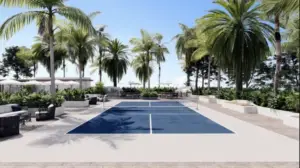Pickleball kitchen rules
The kitchen (or non-volley zone) has a specific set of rules unique to that area of the court. There are 7 pickleball kitchen rules to remember when you play.
- All volleys must be initiated outside of the non-volley zone.
- It is a fault if the volleying player or anything they have contact with (including paddle) while in the act of volleying, touches the non-volley zone.
- It is a fault if the player’s momentum causes the player to contact anything that is touching the non-volley zone, including the player’s partner.
- If a player has touched the non-volley zone for any reason, that player cannot volley a return until both feet have made contact with the playing surface completely outside the non-volley zone.
- A player may enter the non-volley zone at any time except when that player is volleying the ball.
- A player may stay inside the non-volley zone to return a ball that has bounced.
- There is no violation if a player returns the ball while their partner is standing in the non-volley zone.

If these rules seem overwhelming, fear not! We’re going to break each one down to make sure it’s all crystal clear and help you keep your kitchen problems to a minimum.
What exactly is a pickleball kitchen?
I learned what the kitchen was during my first game when my dad yelled at me for stepping in it and costing us a point. EVERYONE makes this mistake at some point — but if you at least know the basics, you’ll make it less.
The kitchen (also known as the no-volley zone) is the area on the court within 7 feet of the net on either side. In this area, players are not allowed to hit the ball before it bounces.
Why is it called the kitchen?
So if this area of the court is formally known as the no-volley zone, why call it the kitchen? Well it’s not because that’s where disasters happen or family holidays are ruined.
Pickleballers nicknamed it the kitchen because it where is often the “hot spot” on the court, where many games are won and lost. Clever, right?

Kitchen strategies for pickleball
Knowing your way around the kitchen is key when you start getting into more competitive matches. Since you can’t make volleys or smashes inside this area, you need to adjust your strategy and of course, follow the rules of the pickleball kitchen.
Pickleball kitchen strategies center on where you place the ball and how you set up the next shots. And since players are not allowed to step into the kitchen to make a shot, they often try to use their footwork and positioning to create angles that will make it difficult for their opponents to defend against the shot.
Breaking down pickleball kitchen rules
Ok now that we’ve covered the basics, let’s get into the rules. Make sure you know these well because no matter how tight your game is, making a mistake will cost you a point and potentially, your pride.
All volleys must be initiated outside of the non-volley zone.
This one is fairly simple. Basically, you can’t volley (hit the ball before it bounces) when you’re in the kitchen.
It is a fault if the volleying player or anything they have contact with (including paddle) while in the act of volleying, touches the non-volley zone.
Again pretty straight forward. If any part of you touches the kitchen while volleying, it’s a no-go. This means if a toe lands on the kitchen line when you volley, it’s a fault.
It is a fault if the player’s momentum causes the player to contact anything that is touching the non-volley zone, including the player’s partner.
Ok so this one is a little funky. But basically if you hit a volley and fall into your partner that is in the kitchen, it’s a fault. Same goes if you go to hit a low ball and your paddle ends up sliding on or over the line.
If a player has touched the non-volley zone for any reason, that player cannot volley a return until both feet have made contact with the playing surface completely outside the non-volley zone.
For this rule think about the kitchen as an out-of-bounds sort of area. If you’re in it, you must get both feet back into the field of play before you volley the ball.
A player may enter the non-volley zone at any time except when that player is volleying the ball.
You can spend all the time you want in the kitchen. You just can’t volley the ball while you’re there. And before you do, see the rule above about establishing yourself before the hit.
A player may stay inside the non-volley zone to return a ball that has bounced.
Remember, all of these rules ONLY apply to volleys — hitting the ball before it bounces. If your opponent lands a short shot that bounces inside the kitchen, you’re allow to charge in there to return.
There is no violation if a player returns the ball while their partner is standing in the non-volley zone.
Finally, it is totally ok to return a ball while your partner is hanging out in the kitchen. These rules only apply when you are the one hitting.
Conclusion
Not too bad right? The kitchen does come with a few quirks, but once you have them down, they’re pretty simple to remember.
Getting up close to the kitchen is generally part of a winning pickleball strategy. So creep on up and smash a couple volleys! Just keep those toes behind the line.

Spencer is writer and website owner from California. He started playing pickleball with his pops and they have a running tally of matches won and lost. Spencer declines comment on where the record stands.









5 thoughts on “Pickleball kitchen Rules: Get your game cookin’”
Comments are closed.